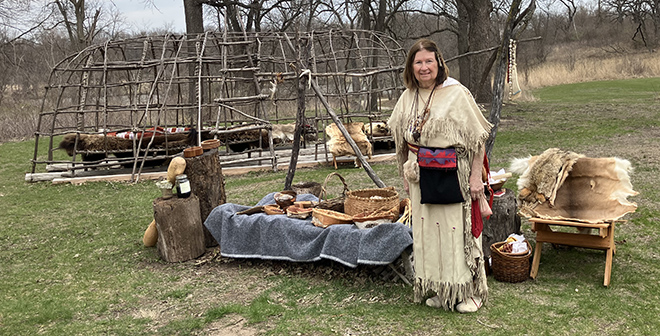Macktown Living History brought past skills into the present, honored Native Pride

MARIANNE MUELLER PHOTO The Herald
Lucy Adrignola shared information on Native American culture at Macktown.
Macktown Living History welcomed families, and visitors to an event showcasing Native Pride on Sunday, April 13.
Educational opportunities were opened to learning the culture of various tribes, while trying hands on activities.
Featured tribes that information was presented on included the HO-Chunk, Sauk, Kaskaskia and the Kickapoo.
Friendly volunteers in the Macktown Living History Center guided visitors before starting their journey on the Macktown grounds.
Lucy Adrignola explained the makings of the Three Sisters Garden.
“When Europeans first arrived in America Indigenous peoples had already figured out very smart ways to grow food. From this the Three Sisters agriculture was popular in both the North and the Southeast. The Iroquois and Cherokee gave this name. Corn, beans and squash “because they work together like a happy family.
“Corn was planted in little hills, the beans were placed around the corn, and squash was added in between these.
The beans are special because they take nitrogen from the air and turn it into food for the soil, which helps the corn and squash grow. In return the beans climb up the corn stalks. Meanwhile the big squash leaves cover the ground, keeping pesky weeds away. These three plants grow much better together.”
A medicine garden produced natural products to promote healing. Birch bark was used as an antiseptic.
Turtle shells were sometimes used as a scraping tool. The river is full of a variety of fish, including shellfish.
A bottle of syrup came on display. Forty gallons of maple sap makes one gallon of maple syrup.
The Native Americans lived in wigwams, not tepees. Inside of a wigwam bison hide was found.
People have lived a total of 8,000 years on the grounds. They had bison, elk and deer. “At one time a total of 350 people lived on the Macktown grounds,” Adrignola said.
Some tried their hand at Archery led by Blackhawk Field Archers.
Archery initially emerged as a technique for hunting and then later warfare. The earliest evidence of archery is related to arrowheads made of flint, which dates back to around 20,000 BC.
Flint Knapping utilized what were called, ‘crude tools’ such as scrappers, choppers, and simple cutting tools that were most likely used for chopping wood, cutting and preparing animal hides, and processing plants.
Atlatl tools first appeared in the western hemisphere approximately 13,000 years ago, (11,000 B.C.E.) and revolutionized hunting practices for indigenous peoples.
Visitors took on this challenge by attempting to hit a target of a deer photo on a throwing board.
Cordage uses a variety of natural materials like plant fibers, (dog bone, nettles cattails, iris, willow, cedar, agave, yucca, animal sinew and rawhide). This involves twisting or braiding to create, strong, durable cordage for various purposes.
Hawk Throwing is done with a small, handheld ax used by Native Americans. This symbolizes both war and peace, acting as a tool for conflict, diplomacy and cultural identity. It is also a ceremonial item in rituals and gift exchanges.
“Tomahawk was derived from Algonquian word, “tomahuk” which means to “knock down.”
In the trading posts visitors created a replica basket.
Stephen Mack Home
One of the sites visited was The Stephen Mack home that was built in 1839. This was the home he shared with Hononegah and their children.
Hononegah was a young Ho Chunk Pottawatomie girl who married Stephen Mack Jr. in 1829. Stephen Mack and Hononegah helped settle this northern area of Winnebago County. She lived successfully in two cultures while raising nine children.
She was born in 1814 in the Four Lake Region; now known as Madison. She was named by her parents, “Hinu Nik Wiga.”
She was orphaned by the age of seven and raised by uncles in Prairie Du Chien, Wis., and later in Grand Detour, Ill., where she first met Stephen Mack.
She died at the age of 33 in 1847 from liver complications. After the death of Stephen Mack, their children were sent to live with family and friends in various parts of the country.
Hononegah’s Fourth Great Granddaughter Michele Mackenthun served as a volunteer in the Mack House during the event. Mackenthun was wearing an authentic Native American outfit crafted by Pam Stock.
Letters written by Stephen Mack were transcribed by Macktown Living History member Linda Sonneson. These books are available to buy for $10.
Archaeology education
Dr. Rochelle Lurie educated on archaeology at Macktown.
Digs are held on the grounds at different times of the year. Archaeological research began with a systematic survey of 30 acres of the 50 acre town platted by Stephen Mack and James Bradstreet in 1936 at the confluence of the Rock and Pecotonic rivers. That survey showed that the entire 30 acres contained artifacts from Naive American campsites, some dating as far back as 8,000 years and Historic pioneer households from the Mack era, ending about 1851.
Since that first survey extensive excavations have been conducted at a shellfish processing area along the Rock River and on the associated Native American campsites on the terraces above. These camps dates primarily from the Middle to Late Woodland periods from 2,500 years ago to about 1,200 years ago.
The majority of archaeological excavations have been conducted at locations of historic structures that are no longer visible on the ground surface.
The Whitman Trading Post
MLH volunteer Peter Czyzewski greeted visitors who entered the trading post. Czyzweski outlined current renovations that have been completed on the building.
“The shelves and the pieces on them are original but we have made a new counter and door. We picked up the lumber in a sawmill in Kirkland IL. It is palette grade,” Czyzweski said.
MLH volunteer Connie Gleasman painted the outer doors and trim on doors and the around the windows.
Stunning wooden floors also remain original.
Written by William McGuffey, the Eclectic First Reader for Young Children with pictures and the Eclectic Primer each offer novel ways of developing young minds, drawing from different sources.
Coffee was sold as a green beans. “If it is green it doesn’t go bad when buying a roast.” Czyzweski said. A cylinder crank kept the beans in motion.
“Linda Sonneson is our new curator. She has been picking up things that are appropriate and time period correct.
The Mack House received a donation of all new furniture from a museum in Kilbourne, Ill.”
One of the goals behind this event is to provide a greater understanding of Native history, leading to not repeating injustices of the past.
Two families won a raffle prize of free entry to all of MLH’s 2025 events!


